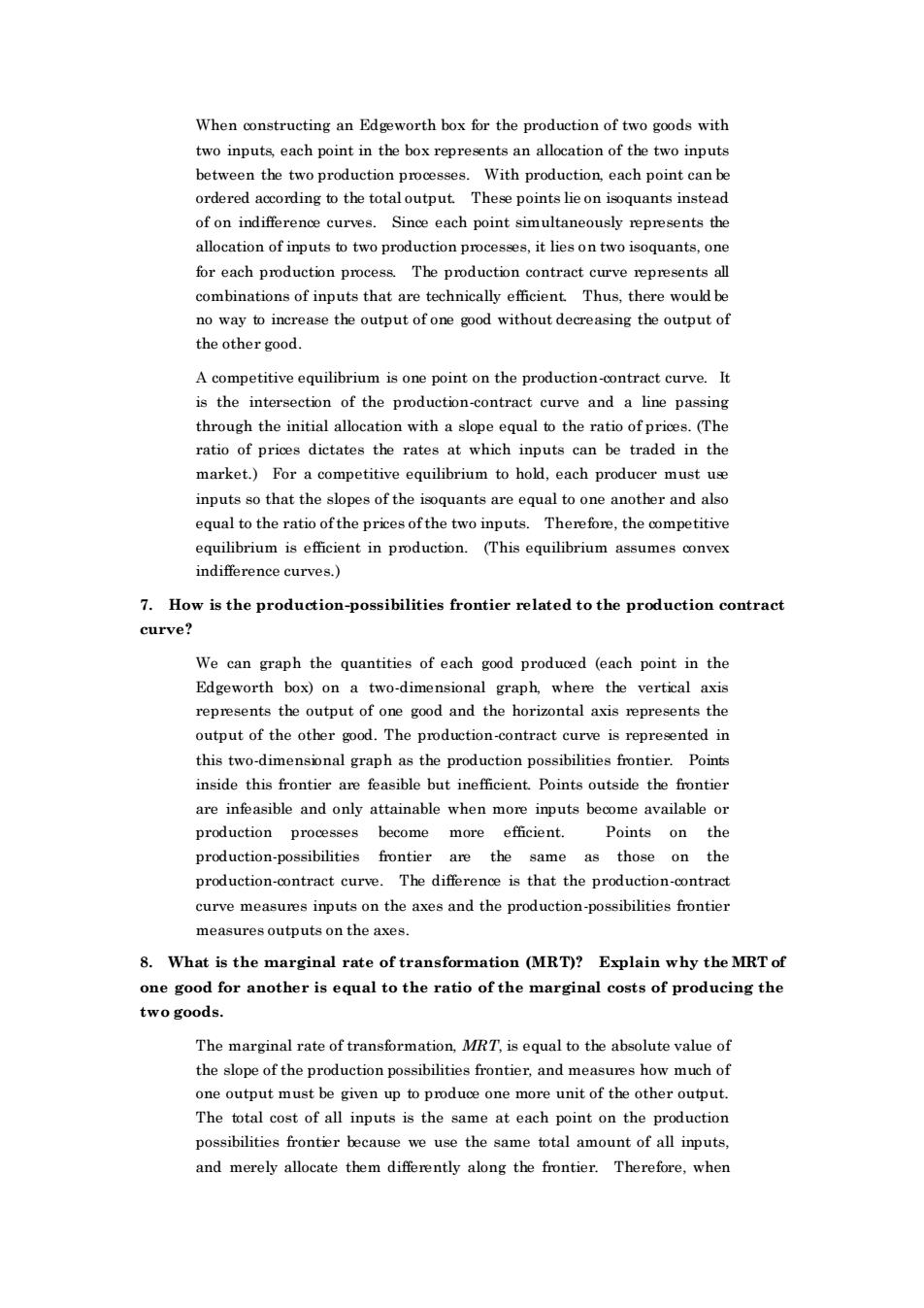正在加载图片...

When oonstructing an Edgeworth box for the production of two goods with between the two production processes. With production,each point can b ordered according to the total output.These points lie on isoquants instead of on indifference curves.Since each point simultaneously represents the allocation of inputs to two production processes.it lies on two isoquants.one oreach productionp combinations of inputs that are technically efficient Thus,there woul be no way to increase the output of one good without decreasing the output of the other good. a competitive equilibrium is one point on the production-contract curve.it is the intersection of the production-contract curve and a line passing through the initial allocation with a slope equo the ratio ratio f prices dictates the rates at which puts can be traded in the market.)For a competitive equilibrium to hold,each producer must use inputs so that the slopes of the isoquants are equal to one another and also equal to the ratio ofthe prices of the two inputs.Therefore,the competitive equilibrium production.(Thisequilibrium assumesonvex curves.) 7.How is the production-possibilities frontier related to the production contract curve' We can graph the quantities of each good produced (each point in the Edgeworth box)on a two-dimensional graph,where the vertical axis represents the output of one good and the horizontal axis represents the output of the other good.The production-contract curve is represented in this two-dimensional graph as heproductionpoesibilhitiesiont Points inside this frontierare feasible but inefficient Points outside the frontie are infeasible and only attainable when more inputs become available or production processes become more efficient. Points on the production-possibilities fmontier are the same as those on the curve measures inputs on the axes and the production-possibilities frontie measures outputs on the axes. 8.What is the marginal rate of transformation (MRT)?Explain why the MRTof one good for another is equal to the ratio of the marginal costs of producing the two goods. The marginal rate of transformation.MrT is equal to the absolute value of the slope of the production possibilities frontier,and measures how much of t must b he ofall inputs is the me at each point on the production given up to possibilities fronter because we use the same total amount of all inputs, and merely allocate them differently along the fmontier.Therefore.whenWhen constructing an Edgeworth box for the production of two goods with two inputs, each point in the box represents an allocation of the two inputs between the two production processes. With production, each point can be ordered according to the total output. These points lie on isoquants instead of on indifference curves. Since each point simultaneously represents the allocation of inputs to two production processes, it lies on two isoquants, one for each production process. The production contract curve represents all combinations of inputs that are technically efficient. Thus, there would be no way to increase the output of one good without decreasing the output of the other good. A competitive equilibrium is one point on the production-contract curve. It is the intersection of the production-contract curve and a line passing through the initial allocation with a slope equal to the ratio of prices. (The ratio of prices dictates the rates at which inputs can be traded in the market.) For a competitive equilibrium to hold, each producer must use inputs so that the slopes of the isoquants are equal to one another and also equal to the ratio of the prices of the two inputs. Therefore, the competitive equilibrium is efficient in production. (This equilibrium assumes convex indifference curves.) 7. How is the production-possibilities frontier related to the production contract curve? We can graph the quantities of each good produced (each point in the Edgeworth box) on a two-dimensional graph, where the vertical axis represents the output of one good and the horizontal axis represents the output of the other good. The production-contract curve is represented in this two-dimensional graph as the production possibilities frontier. Points inside this frontier are feasible but inefficient. Points outside the frontier are infeasible and only attainable when more inputs become available or production processes become more efficient. Points on the production-possibilities frontier are the same as those on the production-contract curve. The difference is that the production-contract curve measures inputs on the axes and the production-possibilities frontier measures outputs on the axes. 8. What is the marginal rate of transformation (MRT)? Explain why the MRT of one good for another is equal to the ratio of the marginal costs of producing the two goods. The marginal rate of transformation, MRT, is equal to the absolute value of the slope of the production possibilities frontier, and measures how much of one output must be given up to produce one more unit of the other output. The total cost of all inputs is the same at each point on the production possibilities frontier because we use the same total amount of all inputs, and merely allocate them differently along the frontier. Therefore, when